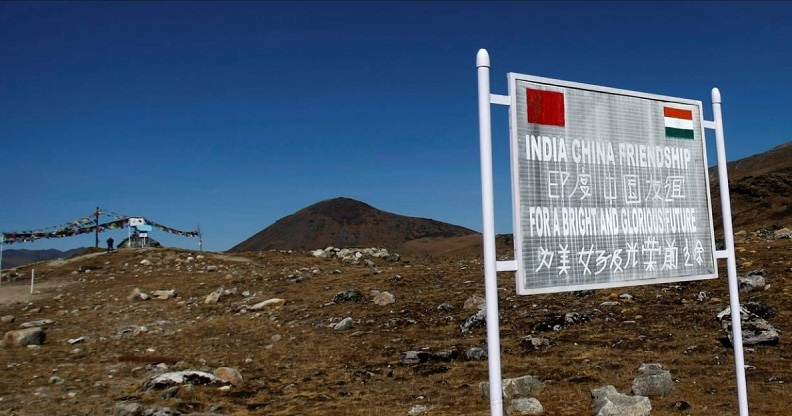India has initiated tit-for-tat nomenclature offensive to counter China’s renaming of places in India’s Arunachal Pradesh, which Delhi suspects, is aimed at strengthening Beijing’s territorial claim on the largest province in northeastern India.
The Indian army’s information warfare division is leading the charge, backed by celebrated research institutes like the British-era Asiatic Society based in Kolkata.
Detailed tweets by the army circulated to under its logo has challenged the Chinese renaming of the seven places in Arunachal and efforts are on to put out counter each of 30 odd places renamed by the Chinese.
Now they have also finalised a list of 30 places in Tibet, reclaiming from historical records their ancient names in Indian languages.
This list, now available with these writers, will soon be made public through media as part of a global campaign to offer a strong counter-narrative to Chinese claims on India’s Arunachal Pradesh state and other parts of the disputed border.
Possibly after a new government takes charge in Delhi — PM Modi’s BJP is expected to return to power — the renaming of places in Tibet, an Autonomous Region of China, will be used as tit-for-tat to defuse Chinese claims on Arunachal Pradesh.
The new names will be backed by extensive historical research, military officials said, but on condition of strict anonymity.
“As and when that happens, it will be tantamount to India reopening the Tibetan question. So long India has accepted Tibet as part of China since it was forcibly occupied by Beijing, but now Modi government seems prepared to change course to deflate the Chinese cartographical and nomenclature aggression,” says former Intelligence Bureau officer Benu Ghosh, who served on the LAC for long years and pursued his mountaineering interests simultaneously.
The Indian Army has in recent weeks organised lots of media trips to these disputed border areas and got them to speak to locals who fiercely oppose Chinese claims and say they were always part of India.
“The ultimate target is to push through the Indian counter-narrative on the disputed border through regional and global media, anchored on both solid historical research and local residents voxpops,” says an officer involved in the campaign but one who does not wish to be identified .
In what is seen as a bid to assert its claim on Arunachal Pradesh, China renamed 30 places along the line of actual control (LAC) in India’s northeastern state.
The Chinese ministry of civil affairs, responsible for the establishment and naming of administrative divisions, released the fourth list of “standardised” geographical names in Arunachal Pradesh recently, which Beijing calls Zangnan, according to a Hong Kong-based daily.
This is the fourth time China has unilaterally renamed places in Arunachal Pradesh, having done it in 2017, 2021 and 2023.
The list of places renamed by China includes 11 residential areas, 12 mountains, four rivers, one lake, one mountain pass and a piece of land. The names have Chinese characters, Tibetan and Pinyin, the Roman alphabet version of Mandarin Chinese.
“In accordance with the relevant provisions of the State Council [China’s cabinet] on the management of geographical names, we in conjunction with the relevant departments have standardised some of the geographical names in Zangnan of China,” South China Morning Post quoted the ministry as saying.
Beijing released the first list of the so-called standardised names of six places in Arunachal Pradesh in 2017, the second list of 15 places in 2021 followed by another list with names for 11 places in 2023.
India has repeatedly rejected China’s move to rename places in Arunachal Pradesh, asserting that the state is an integral part of the country and assigning “invented” names does not alter this reality.
In 2023, then external affairs ministry spokesperson Arindam Bagchi said: “We have seen such reports. This is not the first time China has made such an attempt. We reject this outright.”
He added, “Arunachal Pradesh is, has been, and will always be an integral and inalienable part of India. Attempts to assign invented names will not alter this reality.”
The recent statements by China to reassert its claims over the state started with Beijing lodging a diplomatic protest with India over Prime Minister Narendra Modi’s visit to Arunachal Pradesh, where he dedicated to the nation the Sela Tunnel built at an altitude of 13,000 feet in Arunachal Pradesh.
External affairs minister S Jaishankar on March 23 dismissed China’s repeated claims on Arunachal Pradesh as “ludicrous” and that the frontier state was a “natural part of India”.
“This is not a new issue. I mean, China has laid claim, it has expanded its claim. The claims are ludicrous to begin with and remain ludicrous today,” he said in response to a question on the Arunachal issue after delivering a lecture at the prestigious Institute of South Asian Studies (ISAS) of the National University of Singapore (NUS).
“So, I think we’ve been very clear, very consistent on this. And I think you know that is something which will be part of the boundary discussions which are taking place,” he said.















